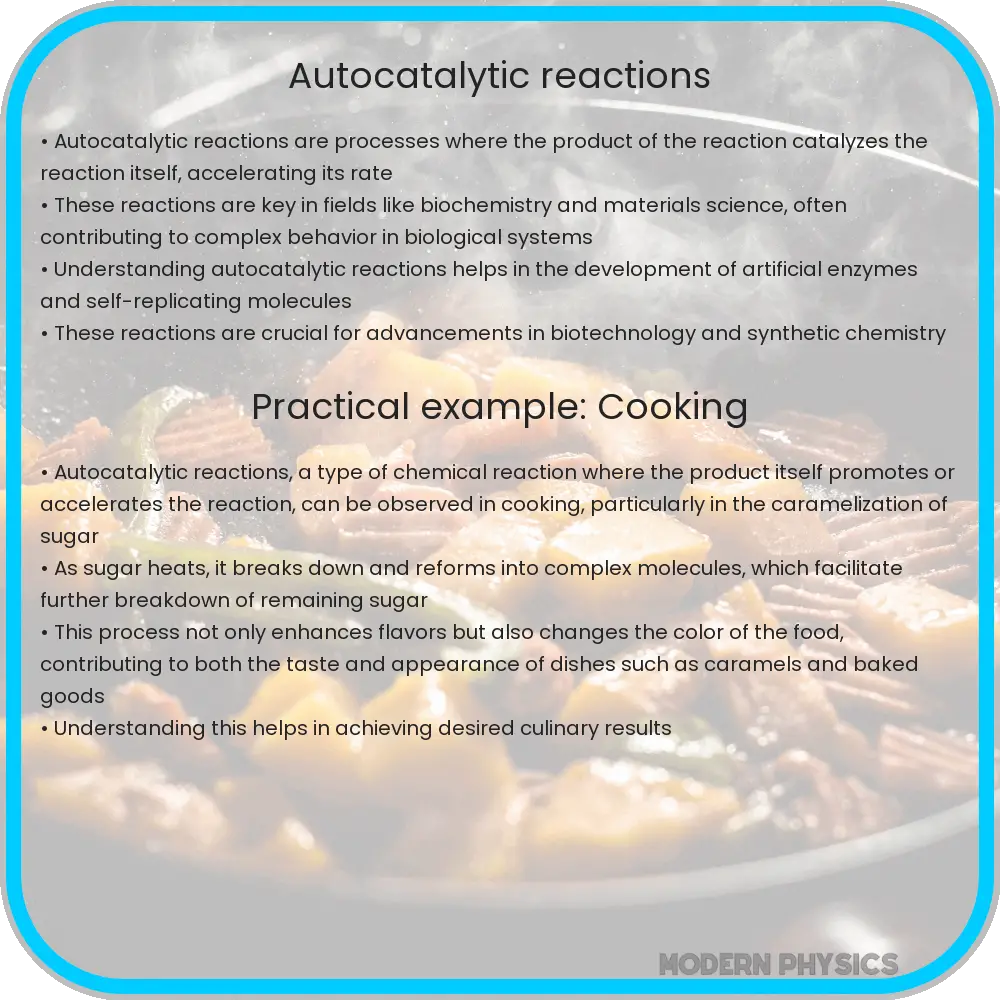Explore the intriguing world of autocatalytic reactions in non-equilibrium systems, their complex dynamics, and broad scientific applications.

Understanding Autocatalytic Reactions in Non-Equilibrium Dynamics
Autocatalytic reactions represent a fascinating area of study in the field of chemical kinetics and non-equilibrium systems. These reactions, where the product of the reaction catalyzes its own formation, are fundamental to various natural and industrial processes. This article delves into the mechanisms of autocatalytic reactions and their role in non-equilibrium dynamics, providing a comprehensive understanding of these self-propagating systems.
The Nature of Autocatalytic Reactions
Autocatalytic reactions are characterized by a unique feedback mechanism where the product of the reaction accelerates its own production. The classic form of an autocatalytic reaction can be represented as:
A + B → 2B
In this reaction, ‘A’ is transformed into ‘B’, and ‘B’ acts as a catalyst for its own formation. Initially, the reaction proceeds slowly due to the limited availability of ‘B’. However, as more ‘B’ is produced, the rate of the reaction increases, leading to a rapid conversion of ‘A’ to ‘B’.
Autocatalysis in Non-Equilibrium Systems
Non-equilibrium dynamics focus on systems that are not in a state of thermodynamic equilibrium. Autocatalytic reactions are crucial in these systems as they drive the system away from equilibrium. The self-amplifying nature of autocatalysis introduces complex behavior in chemical and biological systems, often leading to the formation of spatial and temporal patterns, a phenomenon commonly observed in reaction-diffusion systems.
Applications and Implications
Autocatalytic reactions have significant implications in various fields, including biochemistry, pharmacology, and environmental science. For instance, the autocatalytic nature of enzyme reactions is fundamental to metabolic processes in living organisms. In environmental science, such processes can influence the dynamics of ecosystems and the spread of pollutants.
In pharmacology, understanding autocatalytic reactions can aid in the development of drugs that use or inhibit these reactions. This knowledge is particularly valuable in designing medications for diseases where autocatalysis plays a crucial role, such as in certain neurodegenerative disorders.
Moreover, in the realm of chemical engineering and materials science, autocatalytic reactions are employed in the synthesis of polymers and the development of self-healing materials. These applications demonstrate the broad relevance of autocatalysis in both natural and engineered systems.
In summary, autocatalytic reactions are not just a chemical curiosity but a vital component in the intricate tapestry of natural and engineered systems. Their study offers insights into the complex dynamics of non-equilibrium systems and holds promise for various technological advancements.
This is just the beginning of our exploration into the world of autocatalytic reactions and their impact on non-equilibrium dynamics. Stay tuned for more insights in the next part of this article.
Complex Behavior in Autocatalytic Systems
Autocatalytic reactions contribute to the emergence of complex behaviors in non-equilibrium systems. One such phenomenon is bistability, where a system can stably exist in two different states. This behavior is crucial in biochemical switches and memory devices. Another fascinating aspect is the formation of oscillatory dynamics, as observed in the famous Belousov-Zhabotinsky reaction, where the system undergoes periodic changes in concentration, leading to stunning visual patterns.
Modeling and Analysis of Autocatalytic Systems
To understand these complex dynamics, scientists employ various models and computational techniques. The use of differential equations to model the kinetics of autocatalytic reactions allows for the prediction of system behavior under different conditions. Furthermore, computational simulations, including agent-based models and stochastic simulations, provide insights into the spatial and temporal evolution of these reactions, particularly in heterogeneous environments.
Challenges and Future Directions
Despite the advancements in understanding autocatalytic systems, several challenges remain. One of the primary challenges is the accurate modeling of these reactions in biological systems, where the complexity is magnified by the presence of numerous interacting species. Additionally, the translation of laboratory-scale observations to real-world applications, especially in ecological and environmental contexts, presents a significant hurdle.
Future research in autocatalytic reactions and non-equilibrium systems is poised to explore the uncharted territories of synthetic biology, where designing artificial life forms and biological circuits using principles of autocatalysis could become a reality. Moreover, the integration of machine learning and AI in modeling these systems promises to unlock new understandings and applications, potentially revolutionizing fields from drug discovery to materials science.
Conclusion
Autocatalytic reactions, as a cornerstone of non-equilibrium dynamics, offer a window into the intricate workings of natural and artificial systems. From the self-regulatory mechanisms in biological entities to the design of advanced materials and drugs, the principles of autocatalysis continue to inspire and challenge scientists and engineers. As research progresses, the potential applications and implications of these reactions are bound to expand, further blurring the lines between living and non-living systems and opening up new frontiers in science and technology. The exploration of autocatalytic reactions not only enhances our understanding of the world around us but also paves the way for innovative solutions to some of the most complex problems facing humanity today.
